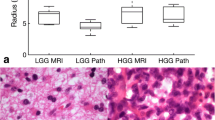Abstract
In neuro–oncology microstructural imaging techniques, like diffusion–weighted MRI (DW–MRI), have been investigated to non–invasively derive patient–specific parameters that can be used for tumour characterization, treatment personalisation and monitoring, response assessment and prediction of radiotherapy outcomes. In particular, DW–MRI is opening up promising perspectives in radiotherapy applications as it is suitable for characterizing tissues at a microscopic scale (microstructure). However, as advanced MRI is rarely acquired in clinical settings, most studies propose metrics extracted from the conventional apparent diffusion coefficient (ADC), despite it being a sensitive but non–specific metric that encapsulates many features of the underlying tissue.
Starting from conventional ADC, a recently published computational framework showed its potential for tumour characterization at the microscopic scale by means of synthetic cell substrates (which mimic the cellular packing of a tumour tissue) and a simulation tool. The aim of this study was (i) to evaluate the effectiveness of an error correction procedure; (ii) to provide a method that accounts for noise in the computational framework; (iii) to obtain a quantitative description of tumour microstructure from DW–MRI images of meningiomas that helps differentiating patients according to their histological sub–type.
Access this chapter
Tax calculation will be finalised at checkout
Purchases are for personal use only
Similar content being viewed by others
References
Aja-Fernández, S., Vegas-Sánchez-Ferrero, G., Tristán-Vega, A.: Noise estimation in parallel MRI: GRAPPA and SENSE. Magn. Reson. Imaging 32(3), 281–290 2014). https://doi.org/10.1016/j.mri.2013.12.001
Bedard, P.L., Hansen, A.R., Ratain, M.J., Siu, L.L.: Tumour heterogeneity in the clinic (2013). https://doi.org/10.1038/nature12627
Bontempi, P., et al.: Multicomponent T2 relaxometry reveals early myelin white matter changes induced by proton radiation treatment. Magn. Reson. Med. mrm.28913 (2021). https://doi.org/10.1002/MRM.28913
Buizza, G., et al.: Improving the characterization of meningioma microstructure in proton therapy from conventional apparent diffusion coefficient measurements using Monte Carlo simulations of diffusion MRI. Med. Phys. 48(3), 1250–1261 (2021). https://doi.org/10.1002/mp.14689
Cook, P.a., Bai, Y., Seunarine, K.K., Hall, M.G., Parker, G.J., Alexander, D.C.: Camino: open-source diffusion-MRI reconstruction and processing. In: 14th Scientific Meeting of the International Society for Magnetic Resonance in Medicine vol. 14, p. 2759 (2006)
Dagogo-Jack, I., Shaw, A.T.: Tumour heterogeneity and resistance to cancer therapies. Nat. Rev. Clin. Oncol. 15(2), 81–94 (2018). https://doi.org/10.1038/nrclinonc.2017.166
Galbán, C.J., Hoff, B.A., Chenevert, T.L., Ross, B.D.: Diffusion MRI in early cancer therapeutic response assessment (2017). https://doi.org/10.1002/nbm.3458
Gurney-champion, O.J., et al.: Quantitative imaging for radiotherapy purposes. Radiother. Oncol. 146, 66–75 (2020). https://doi.org/10.1016/j.radonc.2020.01.026
Gyori, N.G., Palombo, M., Clark, C.A., Zhang, H., Alexander, D.C.: Training Data Distribution Significantly Impacts the Estimation of Tissue Microstructure with Machine Learning. bioRxiv p. 2021.04.13.439659 (2021). https://doi.org/10.1101/2021.04.13.439659
Hall, M.G., Alexander, D.C.: Convergence and parameter choice for monte-carlo simulations of diffusion MRI. IEEE Trans. Med. Imaging 28(9), 1354–1364 (2009). https://doi.org/10.1109/TMI.2009.2015756
Le Bihan, D.: What can we see with IVIM MRI? NeuroImage 187, 56–67 (2019). https://doi.org/10.1016/j.neuroimage.2017.12.062
Leibfarth, S., Winter, R.M., Lyng, H., Zips, D., Thorwarth, D.: Potentials and challenges of diffusion-weighted magnetic resonance imaging in radiotherapy (2018). https://doi.org/10.1016/j.ctro.2018.09.002
Marzi, S., et al.: Early radiation-induced changes evaluated by intravoxel incoherent motion in the major salivary glands. J. Magn. Reson. Imaging 41(4), 974–982 (2015). https://doi.org/10.1002/jmri.24626
Nilsson, M., Englund, E., Szczepankiewicz, F., van Westen, D., Sundgren, P.C.: Imaging brain tumour microstructure (2018). https://doi.org/10.1016/j.neuroimage.2018.04.075
Noij, D.P., et al.: Predictive value of diffusion-weighted imaging without and with including contrast-enhanced magnetic resonance imaging in image analysis of head and neck squamous cell carcinoma. Eur. J. Radiol. 84(1), 108–116 (2015). https://doi.org/10.1016/j.ejrad.2014.10.015
Panagiotaki, E., et al.: Noninvasive quantification of solid tumor microstructure using VERDICT MRI. Cancer Res. 74(7), 1902–1912 (2014). https://doi.org/10.1158/0008-5472.CAN-13-2511
Patterson, D.M., Padhani, A.R., Collins, D.J.: Technology Insight: Water diffusion MRI - A potential new biomarker of response to cancer therapy (2008). https://doi.org/10.1038/ncponc1073
Reynaud, O.: Time-dependent diffusion MRI in Cancer: tissue modeling and applications. Front. Phys. 5(November), 1–16 (2017). https://doi.org/10.3389/fphy.2017.00058
Surov, A., et al.: Histogram analysis parameters apparent diffusion coefficient for distinguishing high and low-grade meningiomas: a multicenter study. Transl. Oncol. 11(5), 1074–1079 (2018). https://doi.org/10.1016/j.tranon.2018.06.010
Surov, A., Meyer, H.J., Wienke, A.: Correlation between apparent diffusion coefficient (ADC) and cellularity is different in several tumors: a meta-analysis. Oncotarget 8(35), 59492–59499 (2017). https://doi.org/10.18632/oncotarget.17752
Tang, L., Zhou, X.J.: Diffusion MRI of cancer: from low to high b-values. J. Magn. Reson. Imaging 49(1), 23–40 (2019). https://doi.org/10.1002/jmri.26293
Thoeny, H.C., Ross, B.D.: Predicting and monitoring cancer treatment response with diffusion-weighted MRI. J. Magn. Reson. Imaging 16, 2–16 (2010). https://doi.org/10.1002/jmri.22167
Tommasino, F., Nahum, A., Cella, L.: Increasing the power of tumour control and normal tissue complication probability modelling in radiotherapy: recent trends and current issues. Transl. Cancer Res. 6(5), S807–S821 (2017). https://doi.org/10.21037/tcr.2017.06.03
Acknowledgments
Partially supported by Associazione Italiana per la Ricerca sul Cancro (AIRC), Investigator Grant-IG 2020, project number 24946. MP is supported by UKRI Future Leaders Fellowship MR/T020296/1.
Author information
Authors and Affiliations
Corresponding author
Editor information
Editors and Affiliations
Rights and permissions
Copyright information
© 2021 Springer Nature Switzerland AG
About this paper
Cite this paper
Morelli, L. et al. (2021). A Microstructure Model from Conventional Diffusion MRI of Meningiomas: Impact of Noise and Error Minimization. In: Cetin-Karayumak, S., et al. Computational Diffusion MRI. CDMRI 2021. Lecture Notes in Computer Science(), vol 13006. Springer, Cham. https://doi.org/10.1007/978-3-030-87615-9_3
Download citation
DOI: https://doi.org/10.1007/978-3-030-87615-9_3
Published:
Publisher Name: Springer, Cham
Print ISBN: 978-3-030-87614-2
Online ISBN: 978-3-030-87615-9
eBook Packages: Computer ScienceComputer Science (R0)




